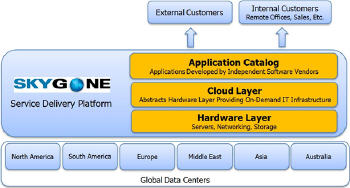That December 2008 day also marked the start of a mission for my team. A mission to learn, understand and become experts on the system architecture and application designs of as many GIS server applications as possible, knowledge that later became indispensable as we created cloud-based deployments of these GIS technologies for TheGISmarketplace.com. But most importantly, that day sparked a belief within our company which continues today... by leveraging our application templating technology, cloud computing capabilities and GIS App Store vision, we possess the potential to have more power and end-user impact than any multi-million dollar GIS software company on the planet. Why? For the simple fact that we aren't a software company at all.
The Cloud... Empowering End-User Choice
We use cloud computing to provide GIS users with the power to easily provision GIS applications and ultimately help them avoid vendor lock-in. By providing production-ready environments in a pay-as-you-go model, customers have on-demand access to enterprise GIS applications from many different vendors. Done using it or it didn't work for you? Okay, shut it down and stop paying. Compare this model to the "traditional" sales cycle of large software vendors, where buyers must trust marketing claims, pay up-front licensing fees, and independently procure hardware before the implementation even begins; we believe people will almost unanimously find the cloud deployment model a more desirable and user-friendly approach to software implementation.
Why Does Enterprise GIS Need an App Store?
The concept of the vendor-neutral App Store is to give end-users and technical buyers the ability to easily compare, deploy and integrate applications from many different GIS software vendors on a common platform. Some of the on-demand applications currently available on our platform include ArcGIS Server, MapServer and GeoServer. ERDAS and OpenGeo software will soon become available, quickly followed by many value-added, solution-focused products from small- to medium-sized GIS vendors.
Understanding the diversity in the GIS market is important since it plays directly into the need for a vendor-neutral App Store where customers can not only become aware of all their software choices, but actually prototype, test and deploy into production different solutions from different vendors. The market share in the GIS industry is more balanced and diverse than many people are aware. A 2009 Daratech report estimated the top three GIS software vendors owned only 56% of the market (ESRI ~30%, Intergraph ~16%, GE Smallworld ~8%), leaving a whopping 44% to those outside of the big three companies. Factor in ERDAS making huge market gains with its new APOLLO product release, Open Source GIS Server applications becoming an ever more popular choice among even the largest GIS enterprises, and a fully supported Open Source GIS product (think "RedHat Linux" model for GIS) by OpenGeo, and that leaves a juggernaut of information for organizations to swallow before making their GIS technology choice.
What Does This Have To Do With Cloud Computing? Everything!
Our approach leverages what we believe is the true power and promise of cloud computing. To the majority of IT users, the real value of cloud computing is less about virtual machines, infinite scalability, and APIs, and much more about simplifying the delivery of applications to their users. If you leverage the true power of cloud computing, it enables the delivery of much more than on-demand IT resources; it delivers "choice" and "ease of use" to end-users.
We use cloud computing as a common platform in which our hosted GIS applications reside; however, it's obtusely over-simplifying things to say that the "cloud" powers our platform. Remember those two scrapped beta systems that we tried with other cloud providers that I mentioned above? They were eighty-sixed after several months of significant development, and were not just simple prototypes. Although this was incredibly counterproductive from a deliverables perspective, the education that resulted from those failed implementations enabled us to deliver a much more enterprise-class product in the end.
Our Choice of Cloud Platform
Our primary concern when selecting a cloud platform was to make sure we met the demands of our customers currently running their enterprise GIS applications on their internal IT infrastructure. Before we began building, we needed to know exactly what consisted within these "enterprise GIS" customer demands. In response, we conducted what I would describe as "somewhat scientific" market research on how customers currently deploy enterprise GIS technology. In short, this research showed that over two-thirds of the customers using enterprise GIS technology had their GIS server "application stack" deployed in a multi-server configuration. More surprisingly, it showed that almost three-quarters of the IT managers at these organizations were frustrated with the GIS operations group because of their outside-of-the-box infrastructure demands. Our reaction to these findings... a simultaneous "great!" and "crap!"
We knew that IT managers being frustrated with GIS would play in our favor because they would be more likely to outsource something they did not covet. However, the idea of convincing organizations to place their complex, multi-tier applications onto the currently available commercial cloud platforms that only provided the ability to spin up single virtual machines and not coherent, pre-configured, multi-tier applications was a daunting task. If we couldn't find a better way to template and manage multi-tier apps, how were we ever going to get enterprise GIS customers onto the cloud? Little did we know the answer was only 80 miles away at a little startup called 3tera.
Although 3tera has since been acquired by software giant CA Technologies, which makes it not such a little startup anymore, the ground-breaking multi-tier application feature that originally drew us to 3tera is still offered through its grid computing software called AppLogic. In addition to multi-tier application support, there is no need for code changes or new installation scripts when placing an application on the AppLogic. In contrast to the effort and customization required to template machine images on other cloud providers (i.e. AMI's), the application you create in AppLogic is simply "wrapped" and becomes a single object secured by its own dedicated firewall no matter how many application tiers, virtual machines or NAS appliances you place inside that boundary.
This ability to take what two-thirds of enterprise GIS customers were already doing - deploying GIS server applications in multi-tier configurations - into the cloud was the breakthrough we were waiting for and ended up changing our organization forever.
Unfortunately, just putting multi-tier apps in the cloud wasn't the only requirement we needed to satisfy. 3tera provided us amazing capabilities at the application level, but we also needed a way to easily deliver these robust applications to users across the globe. So, we did what young companies do best... we built. Using robust Intel Xeon 5500 series Nehalem Processors as our Hardware Layer, AppLogic as a Cloud Layer, and our App Store as the Catalog Layer, we built a Global Service Delivery Platform (GSDP) that sits on top of almost any worldwide data center infrastructure.
Our GSDP enables us with an easy way to provide global access to IT resources and most importantly, the GIS applications which reside upon it. In addition, the GSDP provides global load balancing capability from multiple locations worldwide, a feature that has proven to be vital as Content Delivery Networks (CDN) continue to fail to be a viable option for the GIS industry because of the local processing requirements of the applications on the associated data.
 |
Lucky You
So, what's the moral of the story? Things are getting much easier for end-users of GIS technology. The capabilities of cloud computing simplify the long, daunting tasks of installing and maintaining complex GIS solutions. Now end-users will be able to complete extensive tasks like procuring hardware, installing servers in a data center, configuring networks, installing operations systems and installing GIS applications in a matter of minutes, rather than months.
If you are a GIS professional stuck with an IT manager's burden... consider the cloud your ticket to freedom.
